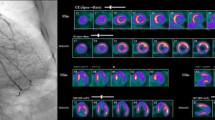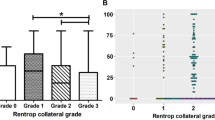Summary
Angiograms from consecutive and unselected patients with acute myocardial infarction were studied with respect to the prevalence as well as the significance of coronary collateral circulation to myocardium distal to the acute coronary occlusion. Methods Coronary angiograms were obtained from 700 consecutive and unselected patients with an acute transmural infarction within 3.7±3 hours (0.5–12) of symptom onset. No patient had undergone iv thrombolysis prior to angiography. Complete and acute vessel occlusion was found in 626/700 patients (89%). Coronary collaterals were detected and graded using Rentrop’s classification. The grade of collateral circulation was related to the clinical course after 30 days and to the global and regional left ventricular wall motion. Results Collaterals were found in 334 patients (69%); 242 patients (38%) had collateral flow grade 2 or 3. Collaterals were demonstrated more frequently in women vs men and in patients with multivessel disease. The prevalence of collaterals was unrelated to age and the presence of diabetes mellitus. Patients who had angiography within 3 hours of symptom onset had collaterals detected less frequently than patients who had angiography beyond 6 hours (66% vs 75%, p<0.05). No collaterals were found in 17/37 patients (47%) in cardiogenic shock and inferior MI but in only 30/164 patients (18%, p<0.01) without shock. Global and regional left ventricular wall motion after 2 weeks was unrelated to the degree of coronary collateral circulation during acute myocardial infarction. Conclusion Collateral circulation to myocardium distal to an acutely occluded coronary artery is detected in 2/3 patients during the acute infarct phase. The absence of collaterals is related to the early occurrence of cardiogenic shock in patients with inferior MI but not to the presence of diabetes mellitus. After direct angioplasty of the infarct vessel, the protective effects of coronary collaterals on chronic LV function remain uncertain.
Zusammenfassung
Um Prävalenz und klinische Bedeutung der Kollateralzirkulation zu Myokard distal eines akuten Koronarverschlusses zu untersuchen, wurden Koronarangiogramme von konsekutiven und unselektierten Patienten mit akutem Myokardinfarkt vor jeglicher Reperfusionstherapie analysiert und mit klinischen Daten korreliert. Methodik Bei 700 konsekutiven und unselektierten Patienten mit akutem ST-Hebungsinfarkt wurde im Mittel nach 3,7±3 Stunden (0,5–12) ein Koronarangiogramm ohne vorangehenden Thrombolyseversuch angefertigt. Bei 626/700 Patienten (89%) lag ein kompletter Koronargefäßverschluss vor. Bei diesen Patienten wurde die Kollateralzirkulation klassifiziert. Der Kollateralisierungsgrad wurde mit klinischen Befunden, dem Verlauf nach 30 Tagen und der globalen und regionalen Wandbewegung korreliert. Ergebnisse Kollateralen waren bei 334/626 Patienten (69%) nachweisbar, bei 242 Patienten (38%) ein Kollateralfluss Grad 2 oder 3. Bei Frauen gegenüber Männern und bei Patienten mit einer Mehrgefäßerkrankung wurden häufiger Kollaterale gefunden. Die Prävalenz von Kollateralen war von Alter und Diabetes mellitus unabhängig. Patienten, die innerhalb von 3 Stunden nach Symptombeginn angiographiert werden konnten, hatten weniger häufig Kollateralen als nach >>;6 Stunden angiographierte Patienten (66% vs. 75%, p<0,05). Von 37 Patienten mit kardiogenem Schock bei Hinterwandinfarkt hatten 17 (46%) keine Kollateralzirkulation gegenüber 30/164 Personen ohne Schock (18%, p<0,01). Die nach etwa 2Wochen angiographisch bestimmte globale und regionale LV-Funktion zeigte keine Abhängigkeit von der Kollateralisierung. Zusammenfassung Eine Kollateralzirkulation zu Myokard distal eines akuten Koronarverschlusses ist angiographisch bei etwa 2/3 der Patienten schon früh nach Infarktbeginn nachweisbar. Die Abwesenheit von Kollateralen ist bei Patienten mit Hinterwandinfarkt mit dem frühen Auftreten eines kardiogenen Schocks assoziiert, nicht aber dem Vorhandensein eines Diabetes mellitus. Ein protektiver Effekt von Kollateralen bezüglich der chronischen LV-Funktion lässt sich nach direkter Angioplastie des Infarktgefässes nicht nachweisen.
Similar content being viewed by others
Author information
Authors and Affiliations
Additional information
Eingegangen: 13. September 2001 Akzeptiert: 12. November 2001
Rights and permissions
About this article
Cite this article
Waldecker, B., Waas, W., Haberbosch, W. et al. Prävalenz und Bedeutung der koronaren Kollateralzirkulation bei Patienten mit akutem Myokardinfarkt. Z Kardiol 91, 243–248 (2002). https://doi.org/10.1007/s003920200018
Published:
Issue Date:
DOI: https://doi.org/10.1007/s003920200018




